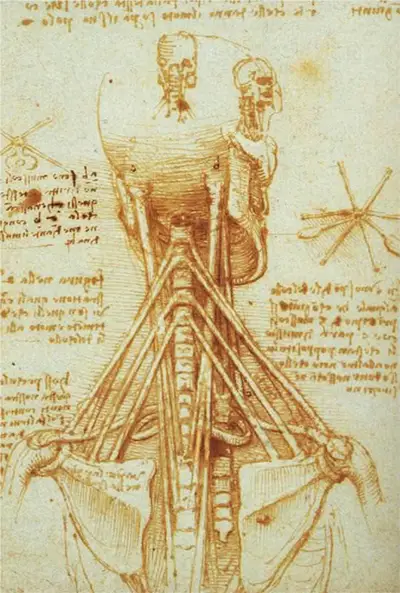His anatomical investigations are still admired today for their accuracy and for the quality of their drawing, and Anatomy of the Neck is just one example of this.
Da Vinci's medical and anatomical investigations spanned much of his career: he was interested in everything from the movement of muscles to the gestation of a baby within the womb.
He was also very interested in comparative anatomy, i.e. the discipline of comparing the anatomical makeup (for example, the skeletal structure) of humans with that of other animals. Anatomy of the Neck can thus be best understood in the context of a much larger and more impressive body of work relating to tendons, muscles, organs and skin.
Like many of his anatomical studies, Anatomy of the Neck is executed using a pen and ink wash over a white chalk background. In addition, it is annotated using da Vinci's characteristic writing.
In his anatomical texts, and in other scientific works such as his engineering related studies, da Vinci was in the habit of writing in back to front mirror writing. That meant that it could be read clearly if it was placed up against the surface of a mirror.
When we look closer at Anatomy of the Neck, we can see the aspects of anatomy that da Vinci was most interested in. He draws lines that represent the way in which movement and force travel along the different parts of the neck.
As such, though it is highly accurate and scientifically motivated, this is also an interpretative work which displays the artist's individual interests and the questions that he was asking.
Anatomy of the Neck is drawn so dynamically that though it was probably modelled on cadavers, it has the appearance of a body that is alive and in motion - albeit with its skin stripped away.
One question that could be asked about Anatomy of the Neck is whether it ought to be analysed as a work of art or as a work of science. One answer is that it is both, and that it depends on what questions we want to ask about the art work.
Do we want to know what scientific facts it conveys or do we want to know how da Vinci applied the chalk, ink and wash to create a realistic effect. In sum, though, the scientific endeavour and the artistic one in Anatomy of the Neck can be said to be inextricable. Da Vinci was a classic Renaissance polymath who wished to explore all branches of knowledge, without dedicating himself to one to the exclusion of the other.


